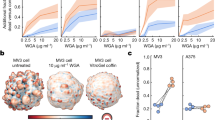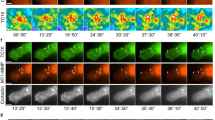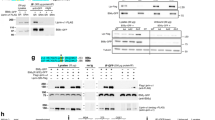Abstract
Met tyrosine kinase has been implicated in tumorigenesis and metastasis; its overexpression and deregulation is often observed in cancer. Although Met's functions in cell motility has been studied extensively, its involvement in bleb-based, amoeboid motility is yet to be determined. The aim of this work is to study the role of Met in amoeboid cell motility and invasion. We show that aggressive breast cancer cells expressing high levels of endogenous Met, as well as HEK293T cells over expressing fluorescent Met, exhibit constitutive, ligand-independent Met activation, leading to Met-dependent membrane blebbing and amoeboid cell motility; HEK293T cells over expressing fluorescent Met were able to invade in three-dimensional matrix. Hyper-activated Met mutant significantly enhances blebbing and cell motility. Met inhibition by either a Met-specific inhibitor or by exogenous expression of a dominant-negative Met remarkably repressed membrane blebbing and invasion. Inhibition of Rho signaling pathway by a ROCK inhibitor also represses Met-induced blebbing, suggesting that Met regulates the blebbing machinery through Rho-ROCK pathway, which controls the actin–myosin contractile force. Either de-polymerization or hyper-polymerization of the actin cytoskeleton abrogates Met-induced blebbing, signifying that actin polymerization has a role in halting and retracting Met-induced mature blebs. Indeed, when blebs retract, membrane wrinkles containing high levels of Met and actin are generated, indicating localized formation of Met-signaling microdomains. We suggest that this bleb-based activity is induced by amplification of Met signaling in unique membrane domains generated by bleb retraction. Our results indicate that Met-induced blebbing has an important role in cell detachment, amoeboid motility and invasion ability, which are utilized by cancer cells for migration and metastasis.
This is a preview of subscription content, access via your institution
Access options
Subscribe to this journal
Receive 50 print issues and online access
$259.00 per year
only $5.18 per issue
Buy this article
- Purchase on Springer Link
- Instant access to full article PDF
Prices may be subject to local taxes which are calculated during checkout







Similar content being viewed by others
References
Zeng Q, Chen S, You Z, Yang F, Carey TE, Saims D et al. Hepatocyte growth factor inhibits anoikis in head and neck squamous cell carcinoma cells by activation of ERK and Akt signaling independent of NFkappa B. J Biol Chem 2002; 277: 25203–25208.
Gherardi E, Birchmeier W, Birchmeier C, Vande Woude G . Targeting MET in cancer: rationale and progress. Nat Rev Cancer 2012; 12: 89–103.
Bottaro DP, Rubin JS, Faletto DL, Chan AM, Kmiecik TE, Vande WG et al. Identification of the hepatocyte growth factor receptor as the c-met proto-oncogene product. Science 1991; 251: 802–804.
Danilkovitch-Miagkova A, Zbar B . Dysregulation of Met receptor tyrosine kinase activity in invasive tumors. J Clin Invest 2002; 109: 863–867.
Peters S, Adjei AA . MET: a promising anticancer therapeutic target. Nat Rev Clin Oncol 2012; 9: 314–326.
Jung KH, Park BH, Hong SS . Progress in cancer therapy targeting c-Met signaling pathway. Arch Pharmacal Res (Research Support, Non-US Gov’t Review) 2012; 35: 595–604.
Friedl P, Wolf K . Tumour-cell invasion and migration: diversity and escape mechanisms. Nat Rev Cancer 2003; 3: 362–374.
Sahai E, Marshall CJ . Differing modes of tumour cell invasion have distinct requirements for Rho/ROCK signalling and extracellular proteolysis. Nat Cell Biol 2003; 5: 711–719.
Keller HU, Bebie H . Protrusive activity quantitatively determines the rate and direction of cell locomotion. Cell Motil Cytoskeleton 1996; 33: 241–251.
Yoshida K, Soldati T . Dissection of amoeboid movement into two mechanically distinct modes. J Cell Sci 2006; 119 (Pt 18): 3833–3844.
Tournaviti S, Hannemann S, Terjung S, Kitzing TM, Stegmayer C, Ritzerfeld J et al. SH4-domain-induced plasma membrane dynamization promotes bleb-associated cell motility. J Cell Sci 2007; 120 (Pt 21): 3820–3829.
Charras GT, Hu CK, Coughlin M, Mitchison TJ . Reassembly of contractile actin cortex in cell blebs. J Cell Biol 2006; 175: 477–490.
Gadea G, de Toledo M, Anguille C, Roux P . Loss of p53 promotes RhoA-ROCK-dependent cell migration and invasion in 3D matrices. J Cell Biol 2007; 178: 23–30.
Kitzing TM, Sahadevan AS, Brandt DT, Knieling H, Hannemann S, Fackler OT et al. Positive feedback between Dia1, LARG, and RhoA regulates cell morphology and invasion. Genes Dev 2007; 21: 1478–1483.
Pinner S, Sahai E . PDK1 regulates cancer cell motility by antagonising inhibition of ROCK1 by RhoE. Nat Cell Biol 2008; 10: 127–137.
Vasiliev JM, Omelchenko T, Gelfand IM, Feder HH, Bonder EM . Rho overexpression leads to mitosis-associated detachment of cells from epithelial sheets: a link to the mechanism of cancer dissemination. Proc Natl Acad Sci USA 2004; 101: 12526–12530.
Corso S, Migliore C, Ghiso E, De Rosa G, Comoglio PM, Giordano S . Silencing the MET oncogene leads to regression of experimental tumors and metastases. Oncogene 2008; 27: 684–693.
Ma PC, Tretiakova MS, Nallasura V, Jagadeeswaran R, Husain AN, Salgia R . Downstream signalling and specific inhibition of c-MET/HGF pathway in small cell lung cancer: implications for tumour invasion. Br J Cancer 2007; 97: 368–377.
Nguyen TN, Wang HJ, Zalzal S, Nanci A, Nabi IR . Purification and characterization of beta-actin-rich tumor cell pseudopodia: role of glycolysis. Exp Cell Res 2000; 258: 171–183.
Vadnais J, Nault G, Daher Z, Amraei M, Dodier Y, Nabi IR et al. Autocrine activation of the hepatocyte growth factor receptor/met tyrosine kinase induces tumor cell motility by regulating pseudopodial protrusion. J Biol Chem 2002; 277: 48342–48350.
Jia Z, Vadnais J, Lu ML, Noel J, Nabi IR . Rho/ROCK-dependent pseudopodial protrusion and cellular blebbing are regulated by p38 MAPK in tumour cells exhibiting autocrine c-Met activation. Biol Cell 2006; 98: 337–351.
Maulik G, Kijima T, Ma PC, Ghosh SK, Lin J, Shapiro GI et al. Modulation of the c-Met/hepatocyte growth factor pathway in small cell lung cancer. Clin Cancer Res 2002; 8: 620–627.
Firon M, Shaharabany M, Altstock RT, Horev J, Abramovici A, Resau JH et al. Dominant negative Met reduces tumorigenicity-metastasis and increases tubule formation in mammary cells. Oncogene 2000; 19: 2386–2397.
Moshitch-Moshkovitz S, Tsarfaty G, Kaufman DW, Stein GY, Shichrur K, Solomon E et al. In vivo direct molecular imaging of early tumorigenesis and malignant progression induced by transgenic expression of GFP-Met. Neoplasia 2006; 8: 353–363.
Moffatt OD, Devitt A, Bell ED, Simmons DL, Gregory CD . Macrophage recognition of ICAM-3 on apoptotic leukocytes. J Immunol 1999; 162: 6800–6810.
Jeffers M, Fiscella M, Webb CP, Anver M, Koochekpour S, Vande Woude GF . The mutationally activated Met receptor mediates motility and metastasis. Proc Natl Acad Sci USA. 1998; 95: 14417–14422.
Miller M, Ginalski K, Lesyng B, Nakaigawa N, Schmidt L, Zbar B . Structural basis of oncogenic activation caused by point mutations in the kinase domain of the MET proto-oncogene: modeling studies. Proteins 2001; 44: 32–43.
Jiang WG, Martin TA, Parr C, Davies G, Matsumoto K, Nakamura T . Hepatocyte growth factor, its receptor, and their potential value in cancer therapies. Crit Rev Oncol Hematol 2005; 53: 35–69.
Christensen JG, Burrows J, Salgia R . c-Met as a target for human cancer and characterization of inhibitors for therapeutic intervention. Cancer Lett 2005; 225: 1–26.
Wolf K, Mazo I, Leung H, Engelke K, von Andrian UH, Deryugina EI et al. Compensation mechanism in tumor cell migration: mesenchymal-amoeboid transition after blocking of pericellular proteolysis. J Cell Biol 2003; 160: 267–277.
Zeng Q, McCauley LK, Wang CY . Hepatocyte growth factor inhibits anoikis by induction of activator protein 1-dependent cyclooxygenase-2. Implication in head and neck squamous cell carcinoma progression. J Biol Chem 2002; 277: 50137–50142.
Charras GT, Coughlin M, Mitchison TJ, Mahadevan L . Life and times of a cellular bleb. Biophys J 2008; 94: 1836–1853.
Cunningham CC . Actin polymerization and intracellular solvent flow in cell surface blebbing. J Cell Biol 1995; 129: 1589–1599.
Arni S, Ilangumaran S, van Echten-Deckert G, Sandhoff K, Poincelet M, Briol A et al. Differential regulation of Src-family protein tyrosine kinases in GPI domains of T lymphocyte plasma membranes. Biochem Biophys Res Commun 1996; 225: 801–807.
Foster LJ, De Hoog CL, Mann M . Unbiased quantitative proteomics of lipid rafts reveals high specificity for signaling factors. Proc Natl Acad Sci USA 2003; 100: 5813–5818.
Douglass AD, Vale RD . Single-molecule microscopy reveals plasma membrane microdomains created by protein-protein networks that exclude or trap signaling molecules in T cells. Cell 2005; 121: 937–950.
Maxfield FR . Plasma membrane microdomains. Curr Opin Cell Biol 2002; 14: 483–487.
Abella JV, Parachoniak CA, Sangwan V, Park M . Dorsal ruffle microdomains potentiate Met receptor tyrosine kinase signaling and down-regulation. J Biol Chem 2010; 285: 24956–24967.
Abella JV, Vaillancourt R, Frigault MM, Ponzo MG, Zuo D, Sangwan V et al. The Gab1 scaffold regulates RTK-dependent dorsal ruffle formation through the adaptor Nck. J Cell Sci 2010; 123 (Pt 8): 1306–1319.
Holowka D, Sheets ED, Baird B . Interactions between Fc(epsilon)RI and lipid raft components are regulated by the actin cytoskeleton. J Cell Sci 2000; 113 (Pt 6): 1009–1019.
Andrews NL, Lidke KA, Pfeiffer JR, Burns AR, Wilson BS, Oliver JM et al. Actin restricts FcepsilonRI diffusion and facilitates antigen-induced receptor immobilization. Nat Cell Biol 2008; 10: 955–963.
Rong S, Segal S, Anver M, Resau JH, Vande Woude GF . Invasiveness and metastasis of NIH 3T3 cells induced by Met-hepatocyte growth factor/scatter factor autocrine stimulation. Proc Natl Acad Sci USA 1994; 91: 4731–4735.
Sambrook A, Fritsch EF, Maniatis T . Molecular Cloning. A laboratory Manual 2nd edn. Cold Spring Harbor Laboratory, New York, NY, USA, 1989.
Acknowledgements
We thank Professor Iafa Keydar for T47D cells and Dr Joyce Taylor-Papadimitriou for HB2 cells. We also thank Dr Yifat Merbl (Harvard medical school) for her critical review of this manuscript. This work was supported by research grants from the Breast Cancer Research Foundation, the United States-Israel Binational Science Foundation and the Federico Foundation Grants.
Author information
Authors and Affiliations
Corresponding author
Ethics declarations
Competing interests
The authors declare no conflict of interest.
Competing interests
The authors declare no conflict of interest.
Additional information
Supplementary Information accompanies this paper on the Oncogene website
Rights and permissions
About this article
Cite this article
Laser-Azogui, A., Diamant-Levi, T., Israeli, S. et al. Met-induced membrane blebbing leads to amoeboid cell motility and invasion. Oncogene 33, 1788–1798 (2014). https://doi.org/10.1038/onc.2013.138
Received:
Accepted:
Published:
Issue Date:
DOI: https://doi.org/10.1038/onc.2013.138
Keywords
This article is cited by
-
TGFβ-induced cytoskeletal remodeling mediates elevation of cell stiffness and invasiveness in NSCLC
Scientific Reports (2019)
-
Loss of ERα induces amoeboid-like migration of breast cancer cells by downregulating vinculin
Nature Communications (2017)
-
TRPV4 Regulates Breast Cancer Cell Extravasation, Stiffness and Actin Cortex
Scientific Reports (2016)
-
Recurrent MET fusion genes represent a drug target in pediatric glioblastoma
Nature Medicine (2016)
-
Annexin A2 binds to endosomes and negatively regulates TLR4-triggered inflammatory responses via the TRAM-TRIF pathway
Scientific Reports (2015)



